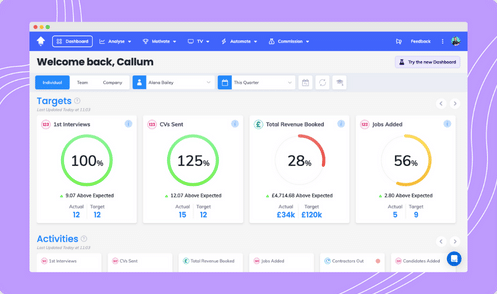Recruitment agencies are constantly under pressure to demonstrate the results of their work.
Because if you’re not providing clear, measurable value, your clients aren’t going to stick around.
That’s where recruiting reports come in.
In this article, we’ll explain what a recruitment report is, discuss the different types of reports you can use and metrics you can track, and present some of the key benefits of recruitment reporting.
Let’s get into it.
Understanding recruitment reports
A recruiting report is a report that details the results of a recruitment campaign — and the context behind those results — by assessing candidate quality and digging into the specific activities performed by the recruiter.
In the context of recruitment agencies, these reports are used by team managers and leaders to improve the productivity and performance of their recruitment reps, help their teams operate more efficiently, and (hopefully) beat their revenue targets.
Types of recruitment reports
A recruitment report isn’t a one-size-fits-all document. Instead, there are various types of reports that cater to different audiences and objectives. Here are some of the most common recruitment reporting types:
Recruitment reports for team management
If you’re a recruitment team leader, it’s your job to focus on the granular details of a recruitment campaign. So you need the following types of reports:
- Daily activity tracking: Your daily recruitment report template should incorporate hyper-specific activity targets, such as the number of calls made and CVs sent by individual recruiters.
- Weekly performance tracking: Rather than looking at activity levels, these reports focus on the results of those activities, such as whether your team are hitting their targets for number of interviews booked or candidates placed.
- Monthly performance tracking: Similar to weekly performance tracking reports, but over a longer period.
- Quarterly performance tracking: Again, these reports are similar to the previous two examples, but they typically take a more holistic view and also incorporate business-critical metrics like the amount of revenue generated by placing candidates.
Recruitment reports for senior leadership
Senior leaders are less in the weeds when it comes to the day-to-day business of running a recruitment campaign. Instead, they want to look at monthly, quarterly, and annual recruitment report documents focussing on bigger-picture metrics and trends like:
- Client and candidate pipeline performance
- Comparisons against historical or benchmark data
- Performance against revenue goals
- Percentage of strategic recruitment goals met
- Key learnings to optimise future campaigns
Recruitment reports for recruitment agency clients
Recruitment agency clients want a clear view of how their recruitment project is progressing. These weekly or monthly status reports should incorporate a range of information and data points, such as:
- The current stage of the recruitment project (e.g. sourcing candidates, making offers)
- Actions and deliverables completed since the previous meeting
- Interviews completed to date, plus their outcome
- Break down of ad spending to date
- Plans for spending any remaining ad budget
- Shortlist of top-performing candidates
- Suggestions for changes to the job specification or candidate requirements, if needed
Of course, the longer you spend compiling recruitment reports (internal and external), the less time you have to find their perfect candidate. (This is where a software solution that enables you to build quick and detailed recruitment dashboards could help, *wink*.)
So you should always balance the client’s desire for detail against your own resources and timelines when deciding how much information to include in these reports.
6 key metrics in recruitment reporting
Recruitment reporting is all about focussing on the most relevant recruitment metrics and adding valuable context to explain why you achieved a certain result (and why it matters). With that in mind, let’s take a look at the most important recruitment reporting metrics to cover:
- Jobs added: The number of new jobs an agency wins to recruit for.
- Candidates added: The number of new candidates an agency signs up.
- CVs sent: The number of CVs sent for each job.
- Interviews booked: The number of interviews successfully booked for each job.
- Placements filled: The number of jobs successfully filled.
- Revenue: The amount of revenue won by placing candidates.
If we exclude the “candidates added” metric, we’re left with the five elements of a fairly typical recruitment pipeline. Then the really key area of analysis for understanding performance and efficiency is the ratios between each of those specific metrics (e.g. the ratio of CVs sent to interviews booked).
In other words, while each metric is individually important for reps, and managers would likely set targets for each of these per rep, from a management perspective looking at ratios to try to analyse and improve performance is critical.
5 benefits of effective recruitment reporting
Broadly speaking, a robust recruitment reporting system helps you gauge the effectiveness of specific recruitment activities, which in turn empowers you to make smarter decisions about future strategy. But let’s zoom in on more specific benefits of effective recruitment reporting:
Benefit 1: Identify your top recruiters
When you know which recruiters are your top performers in terms of productivity and revenue, it’s easier to hire more people like them — thereby boosting your overall performance.
Benefit 2: Find recruitment process efficiencies
There’s always room for efficiency savings in any recruitment agency. Reporting helps you find bottlenecks in your current process and smooth them out, allowing your team to be more productive.
Benefit 3: Drive better results
When you understand what your best (and worst) campaigns look like, you can optimise your systems and processes to do more of what works. That means better results for your clients and more revenue for your recruitment agency.
Benefit 4: Know where your best candidates come from
Chances are, one or two sources generate more — or higher-quality — candidates than others. Recruitment reporting helps you identify those channels so you can focus on them more in future campaigns.
Benefit 5: Motivate your recruiters
By giving reps access to transparent performance metrics, you empower them to be accountable for their targets. And by showing them what the best performers in your agency are doing, you motivate them to level up themselves.
How OneUp can help
Creating effective recruitment reporting is all about numbers. If you can’t get the data you need, fast, your reports will never contain the necessary insights or context.
OneUp can help.
Our recruiting analytics software gives you real-time visibility into your performance via customisable dashboards tailored to the metrics that matter to you. And with our workflow automation, reporting no longer requires hours of leg work: you get the reports you need, when you need them.

It’s the perfect tool to streamline your recruitment reporting process.
Closing thoughts
Different recruitment businesses have different reporting needs.
That’s why the biggest battle to effective recruitment reporting lies in getting your hands on the data and being able to visualise it in a way that you can get meaningful insights.
Because while different recruitment businesses have different needs, they all have one common challenge: a lack of visibility into their performance.
OneUp makes the reporting process quicker, easier, and more valuable. Learn how by requesting your OneUp demo today.

